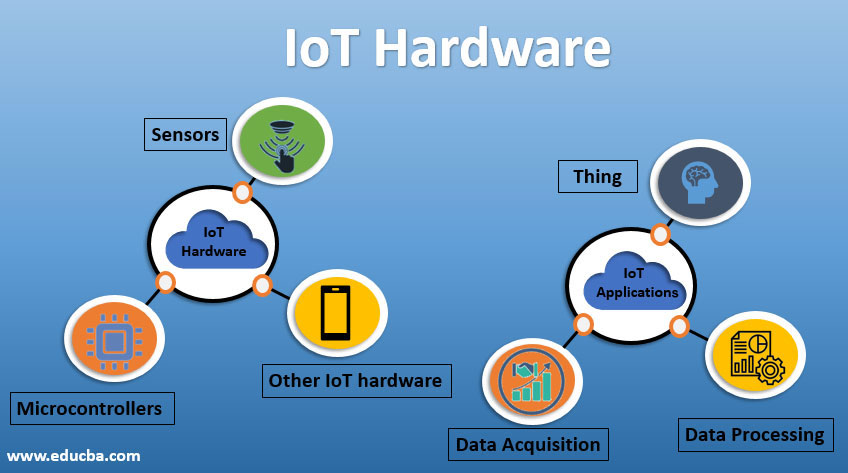Updated May 26, 2023
Introduction to IoT Hardware
In the Internet of Things, hardware comes in many forms, whether the underlying processors control the phones, the sensors collecting information from the physical world, or the edge machines processing and analyzing the data. At the heart of any wired venture is IoT hardware, and the technical capabilities of these boards have only become more critical as the Internet of Things has developed. But, because of the sheer number of design boards and modules in the room, choosing the right IoT hardware for a project can be daunting. In this article, we will look at different aspects of IoT hardware and see how these devices communicate data to the Internet.
IoT Hardware Devices
The building blocks of an IoT device are remarkably similar, whether undertaking projects related to a wearable device, an integrated lighting system, or even a jet engine. Wireless sensor node consists of three major hardware components: sensors, microcontrollers, and communication medium.
1. Sensors
Sensors are the most critical hardware in IoT applications and gather information from the surroundings. These systems comprise power management, RF, energy, and sensing modules. An RF module manages Wi-Fi, Bluetooth, transceiver, BAW, and duplexer communication.
2. Microcontrollers
A microcontroller is a device in a single integrated circuit that executes a single task and runs an application. This contains programmable peripherals for a programmable memory unit and a CPU. Microcontrollers are designed primarily for embedded applications and are widely used in remotely operated electronic devices such as mobile phones, washing machines, microwaves, and cameras.
3. Other IoT hardware
Smart wearable devices such as smart memory, glasses, rings, and shoes are examples of IoT hardware. Smart devices allow us to access more of the content and resources we love and create a new approach to collaboration as part of an IoT network. Desktop, mobile phones, and tablets are standard command centers and remain integral to IoT applications. Other network distribution devices like switches, hubs, and routers act as key connectors in IoT applications.
IoT Hardware Providers
In today’s market, many IoT hardware providers can provide the required hardware based on the project requirement. Let’s take a quick overview of a few of the hardware providers.
- Adafruit offers DIY electronic hacking courses online and provides a space to learn. ‘Adafruit Feather’ is a production line of boards designed for fly prototyping. This production line includes a wide catalog of accessories that speed up IoT application development.
- Arduino is the omnipresent name in the space for electronic development. The company offers a range of open-source development kits, billing software, and microcontrollers.
- Lantronix is a company that offers Infrastructure, modules, and gateway kit to support connectivity between IoT applications. This California-based company has recently launched advanced gateways based on XP200 industrial standards.
- Espressif is well known for its low energy-consuming IoT hardware applications for Wi-Fi and Bluetooth. Espressif is popular for its processors, modules, and production boards series ESP826. Most industry-wide development boards are working on the Espressif chipset.
IoT Applications
All IoT apps have certain commonalities or ‘building blocks’ irrespective of the request. Things, Data Acquisition Module, Data processing module, and communication module comprise the IoT application’s building blocks.
1. Thing
Many IoT products fully integrate The “thing” into the smart device. Think about things such as a smart water pump or an autonomous vehicle. These products can Self-control and manage themselves. In other applications, “thing” stands alone as a “stagnant” device; a different product is connected to make it a smart device. This is very popular in industrial applications where companies have existing products, and by linking them to the Internet, they want to make them “smart.” jet engines, turbines, conveyor belts, etc., are some examples.
2. Data Acquisition
The data acquisition module focuses on obtaining physical signals from the “thing” that can be manipulated by a computer and converting them into digital signals. This hardware component includes all sensors that acquire real-world signals such as temperature, light, vibration, motion, etc. However, the module for data acquisition includes more than sensors. It also includes the appropriate hardware for the computer to convert the sensor signal into digital information. This includes the conditioning of signals, conversion from analog to digital and data interpretation.
3. Data Processing
The third essential component of IoT hardware is the data processing module. This unit performs a series of operations on the data, performs spatial analysis, internal data storage, and performs any other edge computing operations. To have a deep discussion about this system with the engineering team, one doesn’t require any expertise in computer architecture. Your job should be to consider the product’s overarching goal and ask the right questions to direct your team in making the right decisions. The local storage requirement can be decided depending on your data retention policy. If your product is designed for offline operations, connection running time and local storage space must be predefined.
4. Communication
The communication module is the last but essential part of the device’s hardware. This unit allows communication between devices and storage locally or in the cloud space. This module can include, to name a few, communication ports like USB, Modbus, or Ethernet/IP. It may further consist of wireless communication radio technology such as Wireless fidelity.
Conclusion
In this article, we have looked at different building blocks of IoT devices. The hardware component is the most important part of the IoT application, enabling things to communicate with the Internet. We have evaluated a few IoT hardware providers in today’s market and evaluated them individually.
Recommended Articles
This is a guide to IoT Hardware. Here we discuss the introduction, IoT hardware devices and providers, and IoT applications. You can also go through our suggested articles to learn more –



